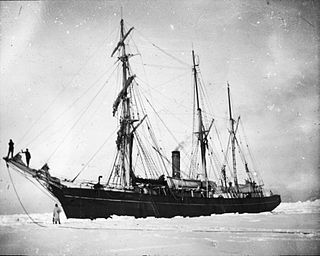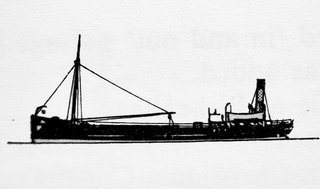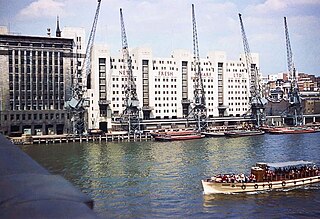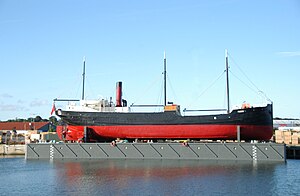
SS Great Britain is a museum ship and former passenger steamship that was advanced for her time. She was the largest passenger ship in the world from 1845 to 1854. She was designed by Isambard Kingdom Brunel (1806–1859), for the Great Western Steamship Company's transatlantic service between Bristol and New York City. While other ships had been built of iron or equipped with a screw propeller, Great Britain was the first to combine these features in a large ocean-going ship. She was the first iron steamer to cross the Atlantic Ocean, which she did in 1845, in 14 days.

SS Yongala was a passenger steamship that was built in England in 1903 for the Adelaide Steamship Company. She sank in a cyclone off the coast of Queensland in 1911, with the loss of all 122 passengers and crew aboard.

Nimrod was a wooden-hulled, three-masted sailing ship with auxiliary steam engine that was built in Scotland in 1867 as a whaler. She was the ship with which Ernest Shackleton made his Nimrod Expedition to Antarctica in 1908–09. After the expedition she returned to commercial service, and in 1919 she was wrecked in the North Sea with the loss of ten members of her crew.

Orchard House Yard was an English shipbuilding yard located at Leamouth, on the River Lea at Bow Creek. Forming part of the Orchard House estate, a number of shipbuilders occupied the site over time:

Sydney Heritage Fleet, is the trading name of Sydney Maritime Museum Ltd., a public company in Sydney, New South Wales, Australia.

SS John Oxley is a steamship that previously served as a pilot boat and lighthouse and buoy tender. The ship was built in Scotland in 1927 for the Queensland Government. The vessel was requisitioned by Royal Australian Navy during the World War II. Returned to her duties after the war, John Oxley remained active until 1968, when her deteriorating condition made her unusable. In 1970, the ship was donated by the Queensland Government to the Lady Hopetoun and Port Jackson Marine Steam Museum for preservation, but due to other projects, work was sidelined until 2004. The ship has undergone restoration for the past 20 years at Rozelle Bay on a floating dock. In April 2022, she was towed to dry dock at Garden Island, re-floated successfully and returned to Rozelle Bay for further restoration work afloat.

SS Aenos, formerly SS Cedar Branch, was a British-built cargo steamship. She was completed in England in 1910 and sunk in the Battle of the Atlantic in 1940.

The SS South Steyne is a former Manly ferry on Sydney Harbour. She was the world's largest steam-powered passenger ferry and operated on the service from 1938 to 1974. Restored in the 1980s, she served as a restaurant ship in Newcastle in the 1990s, and in 2000 was moved back to Sydney and open to the public at Darling Harbour. Since April 2016 she has been stored at Berrys Bay. She was added to the New South Wales State Heritage Register on 2 April 1999.

SS Lanthorn was a 2,299 GRT cargo ship built in 1889 as SS Magnus Mail, renamed in 1916 and sunk by enemy action in 1917. She was a combined steamship and two-masted sailing ship.

SS Traffic was a baggage tender of the White Star Line, built in 1872 by Philip Speakman in Runcorn and made of English Oak.

The first USS Yellowstone (ID-2657) was a cargo ship of the United States Navy that served during World War I and its immediate aftermath.

John Bowes, built on the River Tyne in England in 1852, was one of the first steam colliers. She traded for over 81 years before sinking in a storm off Spain.
SS Telefon was a Norwegian cargo steamship of about 1,400 GRT built by on the River Tyne in 1900. She was wrecked in South Shetland Islands in 1908, though later salved, repaired and returned to service. She was sunk in a collision off Denmark in 1913 as the British Kinneil.

Fresh Wharf was a wharf located in the City of London close to London Bridge, on the north bank of the River Thames. The site was used as a quay in Roman times and later as an unloading place for Anglo-Saxon boats. A wharf was constructed there at some point in the medieval period and appears to have acquired its name from its customary usage as a landing place for fresh fish. In the 16th century, Fresh Wharf was made a "Legal Quay" authorised for the import of certain goods during the reign of Queen Elizabeth I of England. It expanded as London's river-borne trade grew in the 18th and 19th centuries, with large warehouses being established immediately behind the wharf. In the 20th century, the wharf's owners took over the adjoining wharves immediately upstream and downstream, built a new ten-storey warehouse and renamed the site New Fresh Wharf. By the end of the 1960s, however, London's docks had fallen into disuse with the advent of containerization, for which they were not suited, and the wharf was closed down in 1970. An office block was built on the site of the warehouse in 1977 and the former quayside is now part of a public footpath along the Thames.

The MV North Head was a ferry operated by the Port Jackson & Manly Steamship Company and its successors on the Manly service from 1913 until 1985.

Knocker White is a Dutch-built tugboat, currently preserved as a museum ship at Trinity Buoy Wharf. She was built in 1924 by T. van Duivendijk, Lekkerkerk, Netherlands for Harrisons Lighterage Company, under the name Cairnrock.
West Montop was a Design 1013 cargo ship built in 1919 by the Los Angeles Shipbuilding & Dry Dock Co of Los Angeles. She was one of many ships built by the company for the United States Shipping Board.
SS Rosalind was a cargo ship built by Tyne Iron Shipbuilding of Willington Quay and launched in 1879. She operated as a cargo carrier based at Newcastle upon Tyne. In 1907, she was sold to a Swedish operator named N P Shensson and sailed the Baltic Sea until May 1918 when she was sunk by a mine.

Binngarra was a ferry operated by Port Jackson & Manly Steamship Company on the Manly service. Launched in 1905, she was the first of six similar vessels built for the company–the Binngarra class—the success of which saw three of her sister vessels serving through to the 1970s and 1980s.

SS Bärenfels was a German steam cargo liner that was launched in 1921 for DDG Hansa. In 1940, she took part in the German invasion of Norway and was sunk by Fleet Air Arm dive bombers. Her wreck was raised, and in 1941, she was returned to service. In 1944, a Royal Navy midget submarine sank her, killing 11 of her complement. In 1947, her wreck was raised to be scrapped, but while under tow she sank a third time.



















